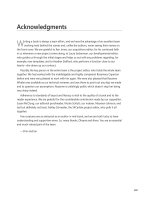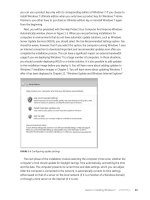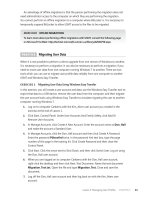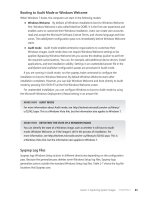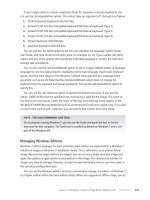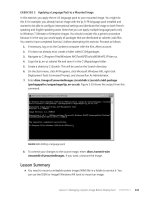Configuring Windows 7 (Training Kit) - Part 5 pdf
Bạn đang xem bản rút gọn của tài liệu. Xem và tải ngay bản đầy đủ của tài liệu tại đây (348.11 KB, 10 trang )
Lesson 1: Installing Windows 7 CHAPTER 1 13
you can use a product key only with its corresponding edition of Windows 7. If you choose to
install Windows 7 Ultimate edition when you only have a product key for Windows 7 Home
Premium, you either have to purchase an Ultimate edition key or reinstall Windows 7 again
from the beginning.
Next, you will be presented with the Help Protect Your Computer And Improve Windows
Automatically window, shown in Figure 1-3. When you are performing installations for
computers in environments that do not have automatic update solutions, such as Windows
Server Update Services (WSUS), you should select the Use Recommended Settings option. You
should be aware, however, that if you select this option, the computer running Windows 7 uses
an Internet connection to download important and recommended updates soon after you
complete the installation process. This can have a significant impact on external bandwidth
usage if you are deploying Windows 7 to a large number of computers. In those situations,
you should consider deploying WSUS or a similar solution. It is also possible to add updates
to the installation image before you deploy it. You will learn more about adding updates to
Windows 7 installation images in Chapter 3. You will learn more about updating Windows 7
after it has been deployed in Chapter 12, “Windows Update and Windows Internet Explorer.”
FIGURE 1-3 Configuring update settings
The next phase of the installation involves selecting the computer’s time zone, whether the
computer’s clock should update for Daylight Savings Time automatically, and setting the time
and the date. The computer presents its current time and date settings, which you can adjust.
After the computer is connected to the network, it automatically corrects its time settings
either based on that of a server on the local network (if it is a member of a Windows domain)
or through a time server on the Internet (if it is not).
14 CHAPTER 1 Install, Migrate, or Upgrade to Windows 7
If the installation routine detects a network during installation, you specify whether the
network is a Home Network, a Work Network, or a Public Network, as shown in Figure 1-4.
The network type that you select determines what services are available from the computer
running Windows 7 and what network locations the computer running Windows 7 can access,
such as the Homegroup feature. If you select the Home Network setting, you select which
libraries and devices you want to share with your Homegroup as well as being shown the
Homegroup password. You will learn more about network locations in Chapter 6, “Network
Settings.”
FIGURE 1-4 Select the network type
After you complete these steps, you are logged on to the Windows 7 installation with the
local administrative account. It may be necessary, at this stage, to install extra device drivers
manually for hardware whose drivers were not installed automatically during installation.
You will learn more about configuring device drivers for Windows 7 in Chapter 4, “Managing
Devices and Disks.”
Dual-Boot Installations
Dual-boot installations allow you to have two or more operating systems installed on the
same computer. For example, you can dual-boot between Windows XP and Windows 7 or
between Windows Vista and Windows 7. When you configure a computer to dual-boot, you
decide which operating system to run at boot time by selecting it from a menu, as shown in
Figure 1-5.
Lesson 1: Installing Windows 7 CHAPTER 1 15
FIGURE 1-5 Dual-boot operating system selection
Dual-booting is becoming less common now that virtualization applications, such as
Microsoft Virtual PC 2007, allow you to run older operating systems when booted into newer
operating systems. Today, dual-booting is most often required for hardware reasons. For
example, if a computer meets the minimum memory requirement for Windows 7 but you
still need to run programs that work only in Windows XP, you would consider a dual-boot
configuration rather than a virtualization solution as the computer running Windows 7 would
not have enough memory to run a virtualized instance of Windows XP. In this situation, you
configure the computer to dual-boot so that the user can access both operating systems.
The key to configuring dual-booting is ensuring that each operating system has its own
partition or hard disk drive. In the event that you do not have a spare partition or hard disk
drive, Windows Vista and Windows 7 include a tool that allows you to resize a volume so
you can create a new volume out of empty space on an existing volume. You can access this
tool through the Disk Management console. To resize a volume, right-click it within the Disk
Management console and then click Shrink Volume.
To dual-boot with Windows 7, you need to be able to create a new volume of at least
15 GB. Even if you have more free space available on the volume you want to shrink, you may
not be able to create a volume of the appropriate size because Windows Vista may not be
able to move some special types of data to a different place on the hard disk drive. Windows
16 CHAPTER 1 Install, Migrate, or Upgrade to Windows 7
XP does not have native tools with which you can shrink existing volumes, though it is
possible to find products from third-party vendors that have this functionality.
When configuring a new computer to boot between multiple operating systems, it is also
necessary to install operating systems in the order that they were released. For example, if you
want to boot between Windows XP and Windows 7 on a new computer, you need to install
Windows XP before you install Windows 7. If you install Windows XP after Windows 7, the
Windows XP installation routine cannot recognize the Windows 7 operating system installation,
and the computer only boots into Windows XP. It is possible to repair the computer from this
point using Windows 7 startup repair so that it dual-boots, but the simplest course of action is
just to install the operating systems in the order in which they were released by Microsoft.
To configure a computer to dual-boot with Windows 7, you can either boot from the
Windows 7 installation media or run the installation routine from within the previous version of
Windows. When presented with the choice of upgrading or performing a custom installation,
shown in Figure 1-6, select the custom installation. If you select Upgrade from Windows XP,
the installation routine terminates because it is not possible to upgrade Windows XP. If you
select Upgrade from Windows Vista, an upgrade occurs and you cannot dual-boot. If you
make this mistake, it is possible to perform a rollback to the original configuration up to the
point where you successfully log on to the new Windows 7 installation.
FIGURE 1-6 Choose custom installation to dual-boot.
The installation process when configuring a computer to dual-boot is the same as when
you are performing a clean installation. The main issue is ensuring that you select the
correct disk or volume when you reach the state where you specify where you want to install
Windows 7. If you specify the volume or disk that hosts the operating system that you want to
Lesson 1: Installing Windows 7 CHAPTER 1 17
dual-boot with, you may end up wiping that volume and replacing it with a fresh installation
of Windows 7. When the installation completes, you can dual-boot between operating
systems and Windows 7 is the default operating system. You will learn about configuring the
default operating system later in this lesson.
Dual-Boot and Virtual Hard Disks
An exception to the rule that you require a separate partition for each operating system
if you want to dual-boot is booting from a VHD file. You can install and then boot Windows 7
Enterprise and Ultimate editions, as well as Windows Server 2008 R2, from VHD files. It is
possible to boot from VHD only on computers that have a Windows 7 or Windows Server
2008 R2 boot environment. This means that you cannot dual-boot Windows XP or Windows
Vista computers with Windows 7 installed on a VHD file, though it is possible to triple-boot
with Windows 7 to VHD if you already have a computer that dual-boots between an earlier
version of Windows and Windows 7. This is because a computer that you have configured to
dual-boot to Windows 7 already has the Windows 7 boot environment present. You will learn
how to install Windows 7 onto a VHD file in Chapter 2.
Configuring the Default Operating System
When you configure a computer to dual-boot, one of the operating systems is selected as the
default. This means that the computer boots into this operating system by default unless the
user intervenes to select the other operating system. To change the default operating system
using the graphical user interface (GUI), perform the following steps:
1. From the Start menu, open the Control Panel. Select Small Icons from the View By
drop-down list.
2. Click System and then click Advanced System Settings. This opens the System
Properties dialog box.
3. On the Advanced tab, click Settings in the Startup And Recovery section. This opens
the Startup And Recovery dialog box, shown in Figure 1-7.
4. From the Default Operating System drop-down list, select which operating system is
booted by default.
To configure the default operating system using the Bcdedit.exe command-line utility,
perform the following steps:
1. Open an administrative command prompt by right-clicking Command Prompt in the
Accessories folder of the Start menu and choosing Run As Administrator. Click OK
when prompted by the User Account Control dialog box.
2. Enter the command bcdedit /enum to view a list of the current boot menu entries,
similar to what is displayed in Figure 1-8.
3. To change the default entry, use the command bcdedit /default and then list the
identifier. In Figure 1-8, this would be {879f7be0-2163-11de-b92d-d86aaca536b1}.
18 CHAPTER 1 Install, Migrate, or Upgrade to Windows 7
FIGURE 1-7 Selecting the default operating system
FIGURE 1-8 Using BCDedit to modify the boot menu
Lesson 1: Installing Windows 7 CHAPTER 1 19
note DUAL-BOOTING ALTERNATIVE OPERATING SYSTEMS
It is also possible to configure a computer to dual-boot between Windows 7 and another
PC operating system, such as Linux, or on a Macintosh computer using special utilities,
Mac OSX. These configurations are unlikely to be tested in the 70-680 exam.
Practice Performing a Clean Installation
You perform a clean installation when you install an operating system on a computer that
does not currently host one. The advantage of a clean installation is that you do not need to
worry about preserving any data that may be already stored on the computer because the
computer does not have any existing data. You perform this type of installation on computers
that have just arrived from the vendor, or when you have replaced a computer’s hard disk
drive and have chosen not to restore the operating system from an existing backup.
exercise Windows 7 Installation
In this exercise, you install Windows 7 on a computer that does not have an existing operating
system. Although the instructions assume that you are using a DVD-ROM installation source,
you can also perform the installation by booting from a specially prepared USB storage
device. Prior to beginning the exercise, ensure that the computer’s BIOS is configured to boot
from the appropriate device.
1. Insert the Windows 7 installation media into your computer’s DVD-ROM drive and turn
on the computer. You may be asked to press a key to boot from the DVD-ROM.
2. On the first page of the Install Windows wizard, shown in Figure 1-9, select which
language you want to use for the installation, the time and currency format that you
want to use, and your keyboard or input method. Click Next.
FIGURE 1-9 Select the installation language.
20 CHAPTER 1 Install, Migrate, or Upgrade to Windows 7
3. Click Install Now. Review the license terms and then check the I Accept The License
Terms check box. Click Next.
4. On the Which Type Of Installation Do You Want? page, click Custom (Advanced). This
allows you to install a new copy of Windows 7.
5. On the Where Do You Want To Install Windows? page, shown in Figure 1-10, select a
disk that has at least 16 GB of free space and click Next. If no disk appears, you may
need to load a driver for your disk by clicking the Load Driver item. Because this is a
clean installation, the disks that appear in this dialog box should not host formatted
volumes.
FIGURE 1-10 Select the disk on which to install.
6. The installation starts. This takes some time depending on the speed of the computer
on which you are installing Windows 7. The computer reboots several times during the
installation process.
7. When you are presented with the page shown in Figure 1-11, enter the user name
Kim_Akers and the computer name Canberra and then click Next.
8. On the Set A Password For Your User Account page, enter the password P@ssw0rd
twice. Enter the password hint as the page number of this page in the training kit. Click
Next.
9. On the Type Your Product Key For Activation page, enter your product key, but clear
the Automatically Activate Windows When I’m Online check box. Click Next.
10. On the Help Protect Your Computer And Improve Windows Automatically page, click
Ask Me Later.
Lesson 1: Installing Windows 7 CHAPTER 1 21
FIGURE 1-11 Enter the user and computer name.
11. On the Review Your Time And Date Settings page, shown in Figure 1-12, configure the
time zone to that of your region, enable adjustment for Daylight Savings Time if your
region uses it, and check the date and Time. Then click Next.
FIGURE 1-12 Time settings
22 CHAPTER 1 Install, Migrate, or Upgrade to Windows 7
12. On the Select Your Computer’s Current Location page, click Home Network.
13. If you are presented with the Do You Want To Create A Homegroup? page, shown in
Figure 1-13, select all libraries and then make a note of your Homegroup password. Click
Next. After you perform this step, the installation is complete. Turn off the computer.
FIGURE 1-13 Create Homegroup
Lesson Summary
n
Windows 7 comes in six different editions. Each edition has a different set of features.
Only the Professional, Enterprise, and Ultimate editions can be configured to join a
domain. Only the Enterprise and Ultimate editions include enterprise features such as
BitLocker, AppLocker, DirectAccess, and BranchCache.
n
Windows 7 comes in two different versions. The 32-bit version is also known as the
x86 version. The 64-bit version is also known as the x64 version. The 32-bit versions
support a maximum of 4 GB of RAM. The x64 versions support between 8 GB and
128 GB, depending on the edition.
n
Windows 7 Home Basic and Starter editions require a 1 GHz x86 of x64 CPU, 512 MB of
system memory, 20 GB HDD, and a 32-MB graphics adapter that supports DirectX9.
n
Windows 7 Home Premium, Professional, Enterprise, and Ultimate editions require a
1 GHz x86 or x64 CPU, 1 GB of system memory, 20 GB HDD, and a 128-MB graphics
adapter that supports a WDDM driver, Pixel Shader 2.0, 32 bits per pixel, and DirectX9
graphics.


